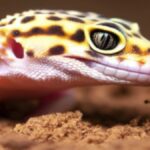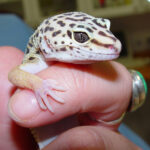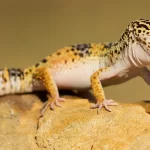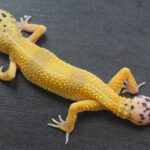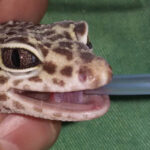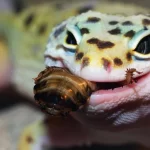
Leopard geckos are known to suffer tail injuries from time to time. This article will tell owners how the injury might have happened, what do to and what to expect when your Leopard gecko has a tail injury.
The tail is the prolonged section extending past the attachment of the back legs. In Leopard geckos, the tail is partially flexible and its main purpose is to store fats and to aid in communication with other Leopard geckos. The innermost structure of the tail consists of vertebrae (called the caudal vertebrae) which is an extension of the spinal cord. The tails of Leopard geckos can also act as a protection mechanism by being expelled in the case of danger.
 Image Jessi Swick (CC BY 2.0)
Image Jessi Swick (CC BY 2.0)
Leopard gecko tail injuries
The tails of Leopard geckos are can be injured in a couple of ways. Although tail injuries in Leopard geckos are not frequently seen and/or is not frequently a major problem, preventative and management measures could aid in minimising the risk for complications.
A Leopard gecko’s tail can be injured in one or more of the following ways:
Many tail injuries in Leopard geckos will result in the loss of the tail (see below). The entire tail, or only a part thereof, can break off. Fortunately, when this happens, the tails of Leopard geckos are designed to withstand serious complications such as infections, pain and severe blood loss. In many cases, the tail will grow back (see later).
Leopard gecko tail drop
Tail dropping in Leopard geckos (also known as autotomy) is when the tail is cast off in the case of danger (e.g. in the case of being chased/attacked by a predator). Autotomy is a natural protection mechanism for Leopard geckos. Although this probably happens more frequently as a result of a physical insult on the tail itself (e.g. the tail being grabbed or bitten), Leopard geckos can spontaneously drop their tails too.
A Leopard gecko’s tail has fracture points and muscles that connect the tail with the spine. Fracture points have weaker connections between them and will break more easily than the rest of the spine. This allows the tail to break more easily in certain areas with less trauma and consequences.
When in danger, the tail muscles will contract which cause enough pressure for the closest fracture point to separate – causing the tail to fall off at that point. After a Leopard gecko dropped its tail, the constriction of the muscles will restrict blood loss and fold over the exposed spinal area to serve as protection.
First aid for Leopard Geckos tail injuries
Although doing nothing will often yield similar results, there are a few things Leopard gecko owners can do in the case where the tail has been injured and/or has broken off. The main aim during this period is to stop the bleeding, prevent infection and to allow the Leopard gecko to rest while recovering.
- The first thing to do in the case of a Leopard gecko tail injury is to separate/isolate it from cage mates. It is best to transfer the injured Leopard gecko to a clean, separate enclosure.
- In the rare cases where there is still active bleeding shortly after the injury has happened, light pressure can be applied using clean non-sticking cotton wool or wound dressing. Pressure should be applied until the bleeding has stopped. Urgently consult with a reptile friendly veterinarian if the bleeding doesn’t stop after a couple of minutes.
- Allow the injured Leopard gecko to rest. Reduce handling to a minimum.
Recovering from tail injuries
A Leopard gecko will take about 2 months to fully recover from a tail injury. By this time, the tail should be starting to grow back. After healing of the wound has taken place (seen as the formation of a knob within 3 to 4 weeks after the injury), the tail tissue will start to enlarge and grow into more or less the old tail structure. Some tails will be shorter than the original one. After the injured tail has grown back, a fairly distinctive line will be visible where the tail has broken off. The original bony vertebrae will grow back in the form of cartilage.
 After the tail has grown back, one can often see the line where the tail fracture occurred.
After the tail has grown back, one can often see the line where the tail fracture occurred.
During the recovery period, injured Leopard geckos should be handled as little as possible. Also see the correct handling of Leopard geckos for more information. Handling should be restricted to moving between containers for cleaning purposes and too quick, close inspections.
The ‘isolation’ enclosure should be cleaned and disinfected frequently. Droppings should be removed daily. The best substrates to use in isolation enclosures are news- or brown butcher paper. Also see suitable substrates to be used for Leopard geckos for more information. To reduce the risk for infection even further, the enclosure should be disinfected with a disinfectant that is safe to be used in Leopard geckos.
 F10 has a wide range of products including wipes, hand soaps, sprays and contact cleaners that is safe and effective to use with Leopard geckos. F10 products are available from certain veterinary clinics and hospitals.
F10 has a wide range of products including wipes, hand soaps, sprays and contact cleaners that is safe and effective to use with Leopard geckos. F10 products are available from certain veterinary clinics and hospitals.
For a Leopard gecko not having a tail means not having additional fat reserves. As the tail grows back, the Leopard gecko needs to replenish its fat reserves. This makes it very important to feed an injured Leopard gecko every day and never skipping a day. During this period both foods high in protein (e.g. crickets and silkworms) and in fat (e.g. mealworms) should be offered. Also see feeding a Leopard gecko for more information.
During the recovery period, guidance from a reptile friendly veterinarian will always have benefits. A veterinarian can help prevent and address complications and can often help with additional medicines that might be needed.

Please press the thumbs-up button if you found this article helpful. 8 other readers already did.
 Loading…
Loading…Donate via PayPal

